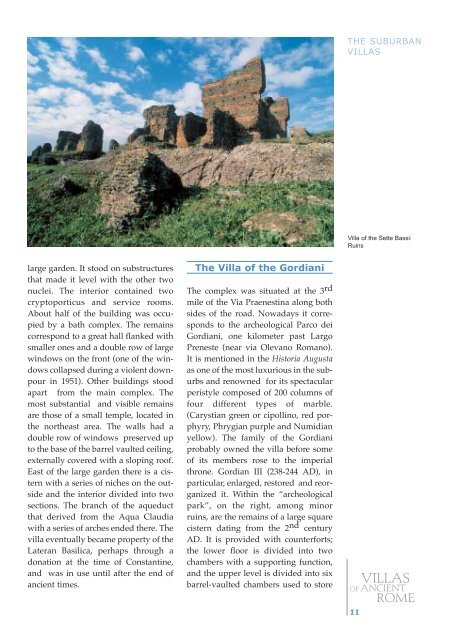You also want an ePaper? Increase the reach of your titles
YUMPU automatically turns print PDFs into web optimized ePapers that Google loves.
THE SUBURBAN<br />
VILLAS<br />
Villa <strong>of</strong> the Sette Bassi:<br />
Ruins<br />
large garden. It stood on substructures<br />
that made it level with the other two<br />
nuclei. The interior contained two<br />
cryptoporticus and service rooms.<br />
About half <strong>of</strong> the building was occupied<br />
by a bath complex. The remains<br />
correspond to a great hall flanked with<br />
smaller ones and a double row <strong>of</strong> large<br />
windows on the front (one <strong>of</strong> the windows<br />
collapsed during a violent downpour<br />
in 1951). Other buildings stood<br />
apart from the main complex. The<br />
most substantial and visible remains<br />
are those <strong>of</strong> a small temple, located in<br />
the northeast area. The walls had a<br />
double row <strong>of</strong> windows preserved up<br />
to the base <strong>of</strong> the barrel vaulted ceiling,<br />
externally covered with a sloping ro<strong>of</strong>.<br />
East <strong>of</strong> the large garden there is a cistern<br />
with a series <strong>of</strong> niches on the outside<br />
and the interior divided into two<br />
sections. The branch <strong>of</strong> the aqueduct<br />
that derived from the Aqua Claudia<br />
with a series <strong>of</strong> arches ended there. The<br />
villa eventually became property <strong>of</strong> the<br />
Lateran Basilica, perhaps through a<br />
donation at the time <strong>of</strong> Constantine,<br />
and was in use until after the end <strong>of</strong><br />
ancient times.<br />
The Villa <strong>of</strong> the Gordiani<br />
The complex was situated at the 3 rd<br />
mile <strong>of</strong> the Via Praenestina along both<br />
sides <strong>of</strong> the road. Nowadays it corresponds<br />
to the archeological Parco dei<br />
Gordiani, one kilometer past Largo<br />
Preneste (near via Olevano Romano).<br />
It is mentioned in the Historia Augusta<br />
as one <strong>of</strong> the most luxurious in the suburbs<br />
and renowned for its spectacular<br />
peristyle composed <strong>of</strong> 200 columns <strong>of</strong><br />
four different types <strong>of</strong> marble.<br />
(Carystian green or cipollino, red porphyry,<br />
Phrygian purple and Numidian<br />
yellow). The family <strong>of</strong> the Gordiani<br />
probably owned the villa before some<br />
<strong>of</strong> its members rose to the imperial<br />
throne. Gordian III (238-244 AD), in<br />
particular, enlarged, restored and reorganized<br />
it. Within the “archeological<br />
park”, on the right, among minor<br />
ruins, are the remains <strong>of</strong> a large square<br />
cistern dating from the 2 nd century<br />
AD. It is provided with counterforts;<br />
the lower floor is divided into two<br />
chambers with a supporting function,<br />
and the upper level is divided into six<br />
barrel-vaulted chambers used to store<br />
VILLAS<br />
OF ANCIENT<br />
1 1<br />
ROME

















